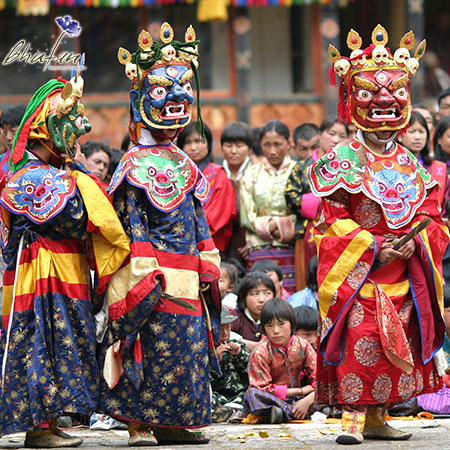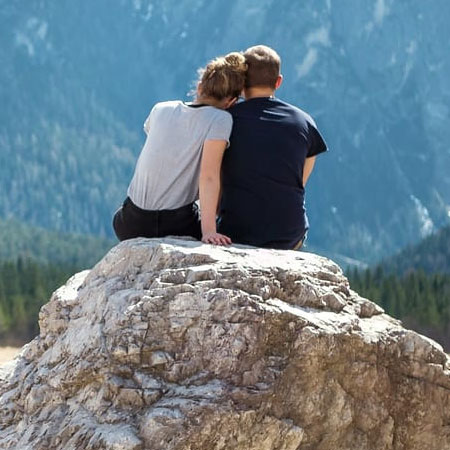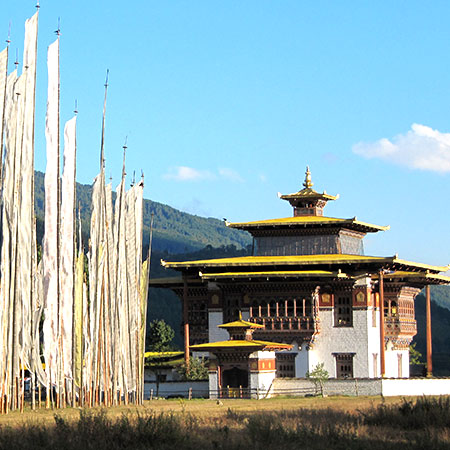Bhutan Dragon's Trail
Tour Duration : 07 Days - 06 Nights
Bhutan Cultural Tour
Bhutan is a remote & independent kingdom in the eastern Himalayas and the last bastion of Tibetan Buddhist culture and religion in its purest form. Bhutan is the only country in the world that has retained the Vajrayana form of Mahayana Buddhism as its national religion. Throughout all of Bhutan there are Buddhist stupas , believed to be a form of protection for tourists and residents. Hinduism is practiced by the southern Bhutanese.
While Bhutan is one of the smallest countries in the world, its cultural diversity and richness are profound. As such, strong emphasis is laid on the promotion and preservation of its unique culture. By protecting and nurturing Bhutan’s living culture it is believed that it will help guard the sovereignty of the nation.

Detailed Itinerary
Day 01 : Arrive Paro
Flight to Bhutan is one of the most spectacular in entire Himalayas. Each flight is a mesmerizing aeronautical feat and offers an exciting descent into the Kingdom. On arrival at Paro International airport, after the immigration and custom formalities done, you will be received by our representative and transfer to the hotel. Evening take a stroll around town’s main street. Overnight at the hotel.
Day 02 : Paro
Morning take an excursion to Taktsang Monastery, also known as Tiger’s Nest. It is believed that Guru Rinpoche, the father of the Bhutanese strain of Mahayana Buddhism, arrived here on the back of a tigress and meditated at this monastery.
After lunch, visit Ta Dzong, the National Museum. The museum collection includes ancient Bhutanese art and artifacts, weapons and country’s exquisite postage stamps. Then walk down the trail to visit Rinpung Dzong situated at commanding height, overlooking Paro valley. This Dzong is symbolic as the religious and secular centre of all affairs of the valley.
Evening visit a traditional farm house to get an idea on lifestyle of local people. Overnight at the hotel.
Day 03 : Paro – Punakha (125 km 5 hours)
After breakfast drive to ruins of Drukgyel Dzong, about 18 km from the town. From this fortress, Bhutanese repelled several invading Tibetan armies during the 17th century. Then visit Kyichu Lhakhang, one of the oldest and most sacred temples of the Kingdom, reflecting the introduction of Buddhism in Bhutan. After that drive to Punakha across Dochula pass (3100m) which heralds the most enchanting views of Bhutan.
Until 1955, Punakha served as the capital of Bhutan and still it is the winter seat of Je Khenpo. Visit Punakha Dzong built in 17th century at the junction of Pho Chhu and Mo Chhu rivers. It has been destroyed by four fires and an earthquake in 1897 and has frequently been devastated by flood water coming from the great northern glaciers. The Dzong has now been fully restored to its original splendor. Evening visit to local market. Overnight at the hotel.
Day 04 : Punakha – Wangduephodrang – Thimphu (90 km 3 hours)
After breakfast, drive to Wangduephodrang. The last town in the west before arriving at the central region of Bhutan, Wangdue is typical small Bhutanese town. The town’s formidable Dzong is its most visible feature. In the 17th century Wangdue played a criticial role in unifying the western, central and southern Bhutanese districts.
After lunch, drive to Thimphu, small charming city sandwiched in the heart of Himalayas. Thimphu’s charm is not only embedded in its wealth of museums or places of historic interest but visitors must wander along the main street and into shops, all of which are decorated in traditional style. Afternoon at leisure. Overnight at the hotel.
Day 05 : Thimphu
Morning visit, Trashichhodzong, situated on the banks of Wang Chhu. It is home of the National Assembly and the summer residence of capital’s venerated monastic community. The Dzong is the impressive result of a redesign of the original medieval structure sanctioned by the Third King, HM Jigme Dorji Wangchuck, when he moved Bhutan’s permanent capital to Thimphu.
Bhutan’s National Library is located close to the Thangkha painting school and contains arguably the best collection of religious and historic literature in the Himalayas. The country has its own brand of Himalayan medicines and this can be seen at the Indigenous Hospital. The Textile and Folk Heritage Museum opened in year 2001 is fascinating testimony of the Bhutanese material culture and living traditions. The Memorial Chhorten, a pious landmark for Thimphu’s residents, was erected in 1974 by the mother of Third King, in memory of her son. Visit Handicrafts Emporium which displays wide assortment of beautifully hand-woven and crafted products.
Overnight at the hotel.
Day 06 : Thimphu – Phunetsholing (179 km 6 hours)
After breakfast, drive to Phuentsholing enroute visit Simtokha Dzong, the oldest fortress of the Kingdom built in 1627, which now houses the School for Buddhist studies. Thimphu / Phunetsholing road was built in 1962 by Dantak, the Indian Border road organization. The drive on this route is very pleasant with numerous scenic spots enroute.
Just before, arriving Phunetsholing, visit Kharbandi Goemba, the monastery built in 1967. It houses the large and attractive statues of Sakyamuni, Shabdrung Ngawang Namgyal and Guru Rinpoche. Overnight at the hotel.
Day 07 : Phuentsholing – Bagdogra/NJP (160 km 6 hours)
After breakfast drive to Bagdogra or NJP Railwaystation for your onwards destination.

































